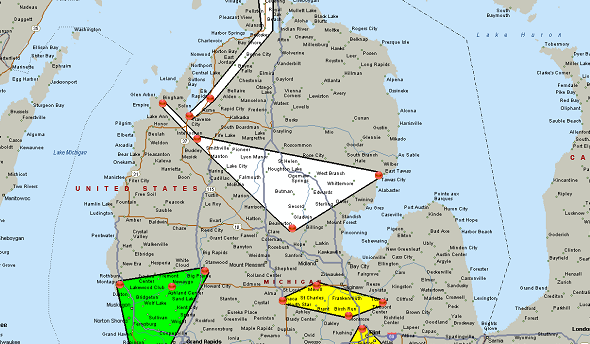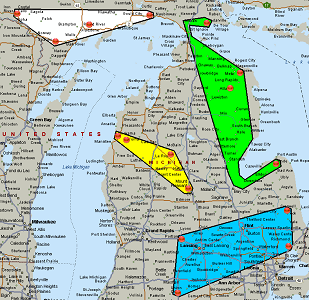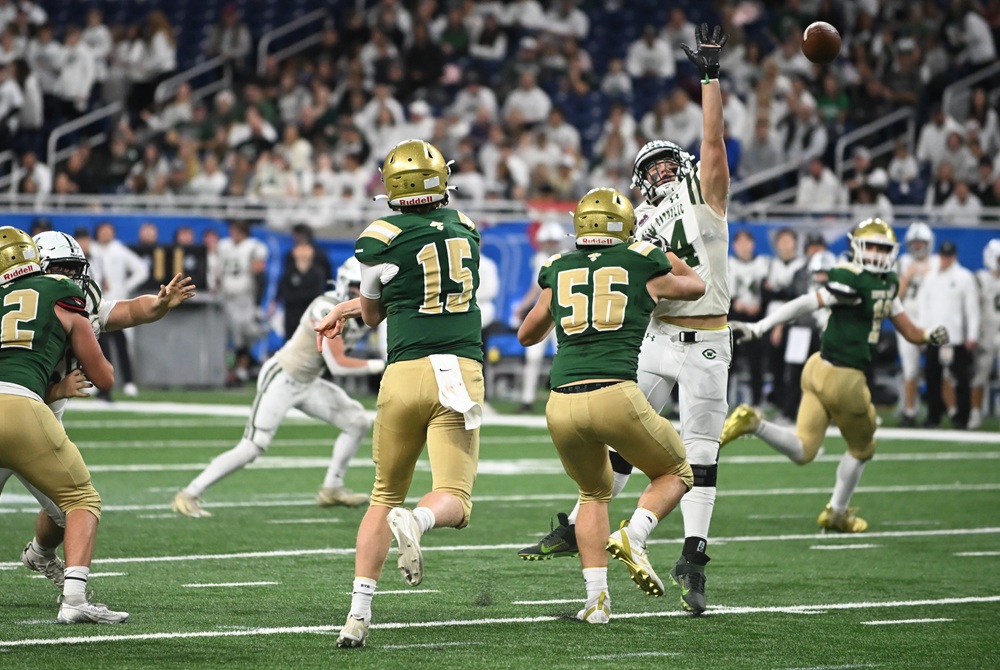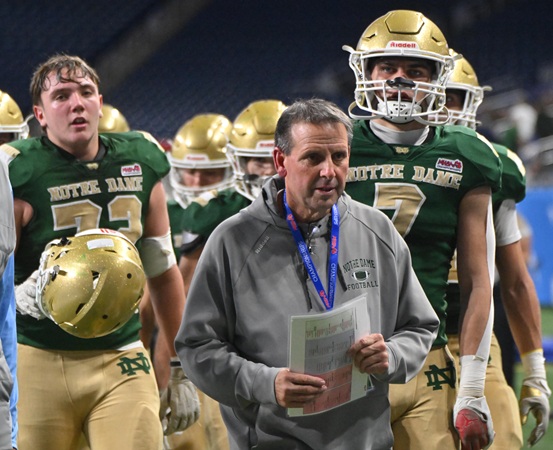
Inside Selection Sunday: Mapnalysis '18
October 21, 2018
By Geoff Kimmerly
Second Half editor
For a fading moment, we thought we saw the Big Dipper floating through the second floor of the MHSAA office Sunday morning.
Michigan’s northernmost high school in Calumet held the handle – but the only place the rest of the Region pointed was to questions about how we could come up with such a disjointed scenario for this season’s Division 6 Playoffs.
Below – as has become an annual tradition – we’ll answer that question and a few more about this year’s selection process.
Our mission Sunday was to map 213 automatic qualifiers for 11-player football – and a record 43 additional qualifiers with 5-4 or 4-4 records – plus our top 32 8-player teams across 10 divisions of playoffs that will conclude with the latter Nov. 17 at Northern Michigan University and 11-player Nov. 23-24 at Ford Field.
As often noted in the past, this process didn’t start Sunday morning – but months and in some cases more than a year ago when athletic directors began scheduling games for this fall. We make sure all are loaded into our system by early summer, and then follow every score/cancellation/forfeit/additional change through Week 9’s final games – including this season those for 46 teams from other states or Ontario that played Michigan schools and needed to be followed as well because their successes affected MHSAA teams’ strengths of schedule.
Now that the maps are drawn, we line up all that will come with the next five weeks of games including assigning officials, gathering potential Semifinal sites and continuing our work with our Finals hosts to create memorable experiences as teams play for championships.
So we’re off. For those familiar with our playoff selection process, or who have read this report in the past and don’t want a refresher on how we do what we do, skip the next section and go directly to the “Observations & Answers: 2018.” For the rest, what follows is an explanation of how we selected the playoff pairings during the morning hours Sunday, followed by how we made some of the toughest decisions plus a few thoughts on the breakdown of the field. Go to this page on MHSAA.com to see the pairings in full.
Ground Rules
Our past: The MHSAA 11-player playoff structure – with 256 teams in eight divisions, and six wins equaling an automatic berth (or five wins for teams playing eight or fewer games) – debuted in 1999. An 8-player tournament was added in 2011, and in 2017 a second division of 8-player football was introduced.
The first playoffs were conducted in 1975 with four champions. Four more football classes were added in 1990 for a total of eight champions each fall. Through 1998, only 128 teams made the postseason, based on their playoff point averages within regions (four for each class) that were drawn before the beginning of the season. The drawing of Districts and Regionals after the end of the regular season did not begin until the most recent 11-player playoff expansion.
In early years of the current process, lines were drawn by hand. Dots representing qualifying schools were pasted on maps, one map for each division, and those maps were then covered by plastic sheets. Districts and Regionals literally were drawn with dry-erase markers.
Our present: After a late Saturday night tracking scores, we file in Sunday morning for a final round of gathering results we may still need (which can include making a few early a.m. calls to athletic directors and coaches). Re-checking and triple-checking of enrollments, what schools played in co-ops and opted to play as a higher class start a week in advance, and more numbers are crunched Sunday morning as the fields are set.
As noted above, this season there were 213 automatic qualifiers for the 11-player field by win total with the final 43 additional qualifiers then selected, by playoff-point average, one from each class in order (A, B, C, D) until the field was filled. There were only five Class D additional qualifiers with 5-4 or 4-4 (playing eight games) records from which we could choose – so with those five we added 13 teams from Class A and B and 12 from Class C.
Those 256 11-player teams are then split into eight equal divisions based on enrollment, and their locations are marked on digital maps that are projected on wall-size screens and then discussed by nearly half of the MHSAA staff plus a representative from the Michigan High School Football Coaches Association. Only the locations themselves are marked (by red dots) – not records, playoff point averages or names of the schools or towns. In fact, mentions of those are strictly prohibited. Records and playoff points are not part of the criteria. Matchups, rivalries, previous playoff pairings, etc. also DO NOT come into play.
The 8-player process is different for team selection and similar for designation of Regionals. We take the top 32 teams in 8-player based on playoff point average as our field, then re-sort those 32 by enrollment – the 16 biggest make up Division 1, followed by the next 16 in Division 2. There are no automatic qualifiers by record for 8-player.
Geography rules: This long has been rule number one for drawing MHSAA brackets in any sport. Travel distance and ease DO come into play. Jumping on a major highway clearly is easier than driving across county-wide back roads, and that’s taken into consideration. Also, remember there’s only one Mackinac Bridge and hence only one way to cross between peninsulas – and boats are not considered a possible form of transportation. When opponents from both peninsulas will be in the same District, distance to the bridge is far more important than as the bird flies.
Tradition doesn’t reign: Every group of 32 (or in 8-player, 16) dots is a new group – these 32 teams have not been placed in a bracket together before. How maps have been drawn in the past isn’t considered – it’s hard to say a division has been drawn in a certain way traditionally when this set of 32 teams is making up a division for the first time.
Observations & Answers: 2018
We always start with CONGRATULATIONS: And this season they go first to Detroit Community, Detroit Public Safety Academy and Dexter, which made the MHSAA Football Playoffs for the first time. Of 611 football varsities across the state, all but 12 have made the playoffs at least once. Rockford missed out on an automatic bid with a Week 9 loss, but received an additional qualifier berth to set the record by making the MHSAA Playoffs for the 24th straight season. Crystal Falls Forest Park (22 seasons), Stevensville Lakeshore (21), Macomb Dakota (18), Climax-Scotts (16) and Grand Rapids West Catholic (16) also extended their stays on the list for longest MHSAA playoff streaks.
Break the tie: We again had to break a tie (actually two for District rounds) as teams that will or could meet ended up with the same playoff point averages. Ties are broken by head-to-head competition first – if the teams played each other during the regular season – followed by opponents’ winning percentage as the second criteria and then a coin flip if those two won’t do it. Our tie-breaks this season both took place in Division 4 – Grand Rapids South Christian received a home game against Wyoming Godwin Heights this week and St. Clair will host North Branch if they meet in a District Final. There are more possible meetings of teams with same averages in later rounds, and those ties will be broken the same way.
What is up with Division 6: Last year I had a “worst map ever,” and two of them this year would be in contention. Division 6 is the first – but the explanation for how we came up with what we did is simple. Region 1 is made up of two Districts with six schools from the northern Lower Peninsula and two from the Upper Peninsula. So however the Districts were sliced, two Lower Peninsula schools had to go with the U.P. And we settled this one strictly by comparing highway mileages of those Lower Peninsula teams to Mackinac Bridge (again, the only way to travel between the peninsulas). In the end, we placed Elk Rapids (93 miles) and Traverse City St. Francis (124) with Escanaba and Ishpeming Westwood because they are closest to the Bridge – followed by Kingsley (126), Maple City Glen Lake (144), Beaverton (161) and Tawas (168). The optics are strange – it may look like Glen Lake is driving past Elk Rapids and St. Francis on the way to Beaverton this week and potentially Tawas next. But Glen Lake’s route still travels south of those two schools this week (and depending on its chosen route on the way to Tawas as well), making everything fit – strangely looking, but nonetheless.
 Lake Huron tour: You could see most of the American side by checking out this week’s Region 2 games in 8-player Division 2. This map also looks odd – there’s a bridge crossing and a drive around Saginaw Bay. Yet, after drawing this at least two more ways, we settled here – although Region 2 looks a little odd, all four teams are east of I-75 and north of Bay City.
Lake Huron tour: You could see most of the American side by checking out this week’s Region 2 games in 8-player Division 2. This map also looks odd – there’s a bridge crossing and a drive around Saginaw Bay. Yet, after drawing this at least two more ways, we settled here – although Region 2 looks a little odd, all four teams are east of I-75 and north of Bay City.
Get your zoom on: We don’t enjoy splitting up teams that live next door to each other, but sometimes it’s a must. In Division 7 we were able to keep all eight Detroit-area and southeastern schools in Region 4, but the distance between its Districts came down to a few miles along I-96. In Division 2, we had to factor in outliers Port Huron Northern and Temperance Bedford – and the resulting Districts ended up splitting Livonia Churchill and Livonia Franklin.
At the end of the day …
I include this every year, but we draw the maps not knowing which schools are represented by the dots. At one point Sunday morning, I was wrong about which division we were considering at the time – and that’s a good thing. For the map drawing portion, it doesn’t matter.
But now that we know who is going where, here’s a glance at some stories that might emerge this week:
• We’ve got rivalries, like Portage Northern at Portage Central and Birmingham Groves at Birmingham Seaholm in Division 2, St. Johns at DeWitt and Haslett at East Lansing in Division 3, Constantine at Schoolcraft in Division 6 and Waterford Our Lady at Clarkston Everest Collegiate in Division 8 – plus Kingston at Deckerville in 8-player Division 1. There are many more we could mention – and some potential feuds renewed in two weeks as well depending on who wins this round.
• The Macomb Area Red, generally considered one of the strongest leagues annually in the state, sent four of six teams to the Division 1 playoffs – and they’re all in the same District. Champion Clinton Township Chippewa Valley (9-0) takes on Utica Eisenhower this week, and with a win would face either Macomb Dakota or Romeo after defeating both by just seven points during the regular season.
• Perhaps the most intriguing opener statewide is River Rouge (8-1) at Detroit Martin Luther King (7-2) in Division 3. Neither gets tested much during their league seasons, but both played tough nonleague opponents and the winner will be considered a favorite to make it to Ford Field.
• Farmington Hills Harrison holds the records for most MHSAA Finals appearances (18) and titles (13) and will play its final playoffs in Division 4 after finishing Division 3 runner-up a year ago. The school is closing next spring. Coach John Herrington is the winningest in state history with 441 wins and counting against only 111 losses (and a tie).
• There are a few annual powers not in the bracket this season – most notably Lowell, Muskegon Catholic Central and Menominee – and others like Rockford, Mendon and Grand Rapids West Catholic got in as additional qualifiers. West Catholic has won five straight Division 5 championships and opens at Hudsonville Unity Christian. The Falcons won the 2013 title after also entering as a 5-4 team.
• There are 34 teams entering the playoffs unbeaten, but only four Districts have multiple – Manistee and Reed City share one in Division 5, Traverse City St. Francis and Calumet in Division 6, Reading and Ottawa Lake Whiteford in Division 8, and Wyoming Tri-unity Christian and Morrice in 8-player Division 1. All of those potential matchups would happen in 11-Player District or 8-Player Regional Finals.
• This will be the eighth year of the 8-player tournament, and in Division 1 only Deckerville in 2012 has won an MHSAA championship in this format. In Division 2, reigning champion Crystal Falls Forest Park opens with 2015-16 back-to-back champion Powers North Central.
• In 8-player, three teams with 5-4 records didn’t make the field of 32, and two teams with 4-5 records advanced. This is the reality of measuring by playoff point average. Fife Lake Forest Area and Webberville are the 4-5 teams, and their opponents this season won more than 61 percent of their games. The three teams at 5-4 and one at 4-4 had opponents’ winning percentages between 38-56 percent.
Every school and every community can tell a story of making these playoffs, and over the next five weeks the fortunate will continue to write chapters filled with moments that will never be forgotten. We’re looking forward to watching them all unfold.
PHOTOS: (Top) The Division 6 map shows an odd-looking scenario with two Traverse City-area teams in the same District as two from the Upper Peninsula. (Middle) The 8-player Division 2 map shows how schools are connected to a District along the Lake Huron shoreline.

Notre Dame Prep Seniors Leave Legacy in Leading Irish to Historic Heights
By
Keith Dunlap
Special for MHSAA.com
December 11, 2025
DETROIT – Understandably, Pontiac Notre Dame Prep head football coach Pat Fox couldn’t even get the words out before getting choked up.
 At the start of the postgame press conference following his team’s 42-14 loss to Grand Rapids West Catholic in the Division 5 championship game Nov. 30, Fox tried to introduce several members of a historic senior class.
At the start of the postgame press conference following his team’s 42-14 loss to Grand Rapids West Catholic in the Division 5 championship game Nov. 30, Fox tried to introduce several members of a historic senior class.
Then, the reality set in that he wouldn’t get to coach them again.
“I love my kids, and it’s hard to say goodbye,” Fox said while fighting back tears.
With a Division 5 championship last year and a runner-up finish this fall, Notre Dame Prep has likely established itself as a perennial contender with such a great foundation laid during Fox’s 12 years at the helm.
But to Fox’s point, it certainly will be hard for future players at the school to top the standards set by this year’s senior class.
Notre Dame Prep had never advanced to an MHSAA Final before the last two years and wasn’t a program known for sustained playoff runs.
“They were (32-5) as a group,” Fox said, referring to the team’s combined record the last three years.
What made it even harder for Fox was that he has known those seniors since they were starting kindergarten at the school.
Fox recited a story about how quarterback Sam Stowe, who threw for more than 5,000 yards combined over the last two seasons, took something from his sister during a holiday concert at the school when they were young kids, and Stowe’s sister tried tackling him to get it back.
 Standouts such as linebacker Brody Sink, who has signed with Miami (Ohio), wideout Drake Roa, running back Ben Liparoto, and linemen Henry Ewles and Jack Williams also have been in the building with Fox for seemingly their whole lives and last year helped deliver Fox and the school their first Finals championship.
Standouts such as linebacker Brody Sink, who has signed with Miami (Ohio), wideout Drake Roa, running back Ben Liparoto, and linemen Henry Ewles and Jack Williams also have been in the building with Fox for seemingly their whole lives and last year helped deliver Fox and the school their first Finals championship.
“I’ve known all of them since they were little boys,” Fox said.
Sink said if there was a turning point where the seniors knew they could help take the program to heights never before attained, it came when they were sophomores.
“My sophomore season, we had a great team, a great quarterback and great players,” Sink said. “We ended up losing to a really good Corunna team (in a District Final). But I didn’t hang my head. I knew we’d come back next year. We had a great (senior) class coming back last year and knew it would be something special for the next two seasons. We stayed the course, and it was a very special last two years.”
After going 9-1 two years ago, Notre Dame Prep went 12-1 last fall and 11-3 this season.
Through it all, the group became heroes to younger kids in the school, who regularly came up to them in the halls to say congratulations or just chat.
“It’s pretty cool,” Stowe said. “I used to be that kid too, looking up to all the Notre Dame Prep quarterbacks. To be that guy, you have to appreciate it and I’m totally humbled to be in the spot where I’m at today.”
Fox did say that before the senior class arrived at the varsity level, the program was “knocking on the door for a while” of becoming a state power, citing a close loss in Districts to eventual Division 4 champion Detroit Country Day in 2020 as one example.
Ultimately, it was this senior class that busted through that door, and now Fox hopes those younger players will take the torch and keep the program among the best in the state.
“You would hope they do,” Fox said. “But every year is different and every challenge is great. We have great kids.”
 Keith Dunlap has served in Detroit-area sports media for more than two decades, including as a sportswriter at the Oakland Press from 2001-16 primarily covering high school sports but also college and professional teams. His bylines also have appeared in USA Today, the Washington Post, the Detroit Free Press, the Houston Chronicle and the Boston Globe. He served as the administrator for the Oakland Activities Association’s website from 2017-2020. Contact him at [email protected] with story ideas for Oakland, Macomb and Wayne counties.
Keith Dunlap has served in Detroit-area sports media for more than two decades, including as a sportswriter at the Oakland Press from 2001-16 primarily covering high school sports but also college and professional teams. His bylines also have appeared in USA Today, the Washington Post, the Detroit Free Press, the Houston Chronicle and the Boston Globe. He served as the administrator for the Oakland Activities Association’s website from 2017-2020. Contact him at [email protected] with story ideas for Oakland, Macomb and Wayne counties.
PHOTOS (Top) Pontiac Notre Dame Prep quarterback Sam Stowe (15) throws a pass during the Division 5 Final while protected by lineman Adrian Fernandez (56). (Middle) Fighting Irish coach Pat Fox leads his team – including Henry Ewles (72) and Brody Sink (7) – off the field.

